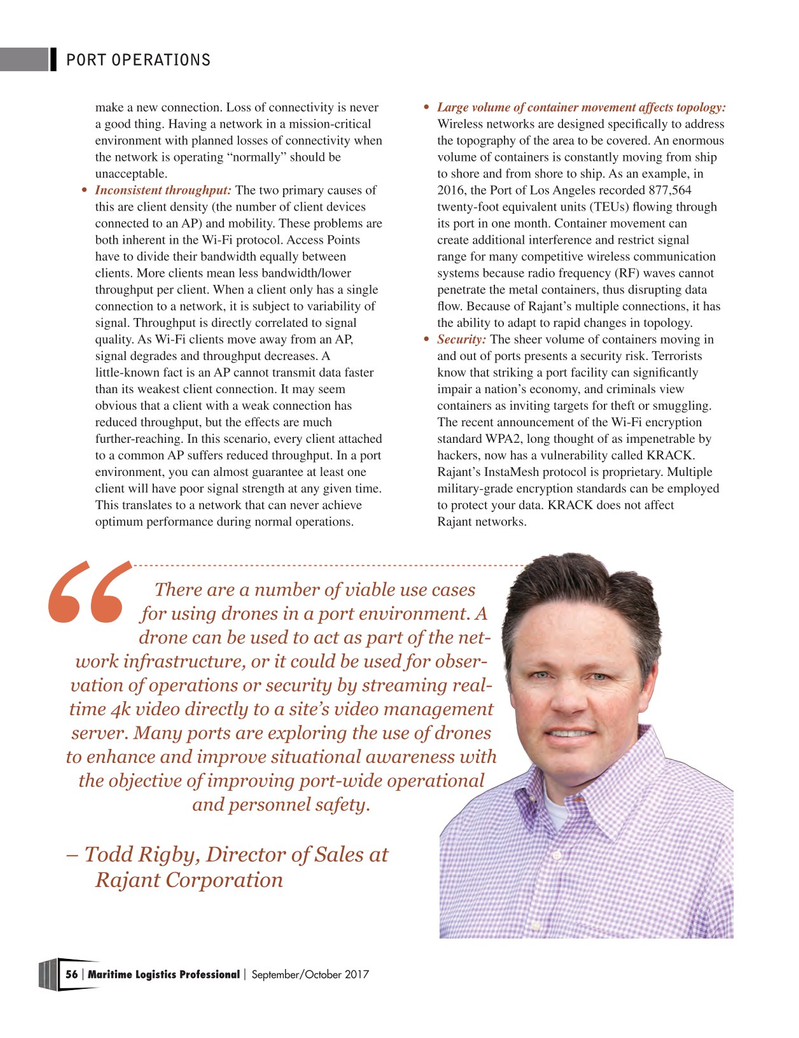
Page 56: of Maritime Logistics Professional Magazine (Sep/Oct 2017)
CONTAINER PORTS
Read this page in Pdf, Flash or Html5 edition of Sep/Oct 2017 Maritime Logistics Professional Magazine
PORT OPERATIONS mak e a new connection. Loss of connectivity is never • Large volume of container movement affects topology: a good thing. Having a network in a mission-critical Wireless networks are designed specifcally to address en vironment with planned losses of connectivity when the topography of the area to be covered. An enormous the network is operating “normally” should be v olume of containers is constantly moving from ship unacceptable. to shore and from shore to ship. As an example, in • Inconsistent throughput: The two primary causes of 2016, the Port of Los Angeles recorded 877,564 this are client density (the number of client devices twenty-foot equivalent units (TEUs) fowing through connected to an AP) and mobility. These problems are its port in one month. Container movement can both inherent in the Wi-Fi protocol. Access Points create additional interference and restrict signal ha ve to divide their bandwidth equally between range for many competitive wireless communication clients. More clients mean less bandwidth/lower systems because radio frequency (RF) waves cannot throughput per client. When a client only has a single penetrate the metal containers, thus disrupting data connection to a network, it is subject to variability of fo w. Because of Rajant’s multiple connections, it has signal. Throughput is directly correlated to signal the ability to adapt to rapid changes in topology. quality . As Wi-Fi clients move away from an AP, • Security: The sheer volume of containers moving in signal degrades and throughput decreases. A and out of ports presents a security risk. Terrorists little-known fact is an AP cannot transmit data faster kno w that striking a port facility can signifcantly than its weakest client connection. It may seem impair a nation’s economy, and criminals view ob vious that a client with a weak connection has containers as inviting targets for theft or smuggling. reduced throughput, but the effects are much The recent announcement of the Wi-Fi encryption further -reaching. In this scenario, every client attached standard WPA2, long thought of as impenetrable by to a common AP suffers reduced throughput. In a port hack ers, now has a vulnerability called KRACK. en vironment, you can almost guarantee at least one Rajant’ s InstaMesh protocol is proprietary. Multiple client will have poor signal strength at any given time. military-grade encryption standards can be employed This translates to a network that can never achieve to protect your data. KRACK does not affect optimum performance during normal operations. Rajant networks.
There are a number of viable use cases for using drones in a port environment. A drone can be used to act as part of the net- work infrastructure, or it could be used for obser- vation of operations or security by streaming real- time 4k video directly to a site’s video management server. Many ports are exploring the use of drones to enhance and improve situational awareness with the objective of improving port-wide operational and personnel safety.
– Todd Rigby, Director of Sales at Rajant Corporation 56 Maritime Logistics Professional September/October 2017 | |

 55
55

 57
57
